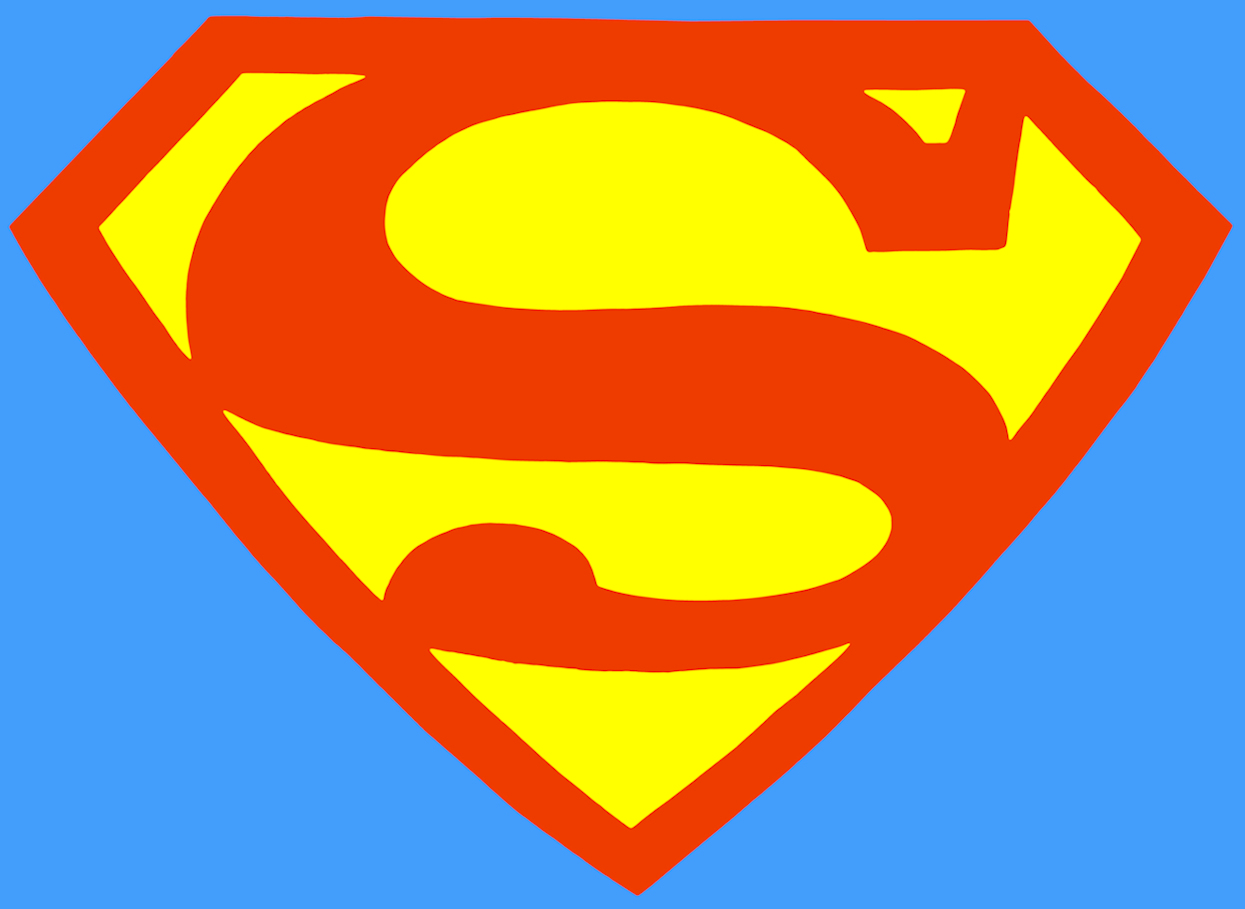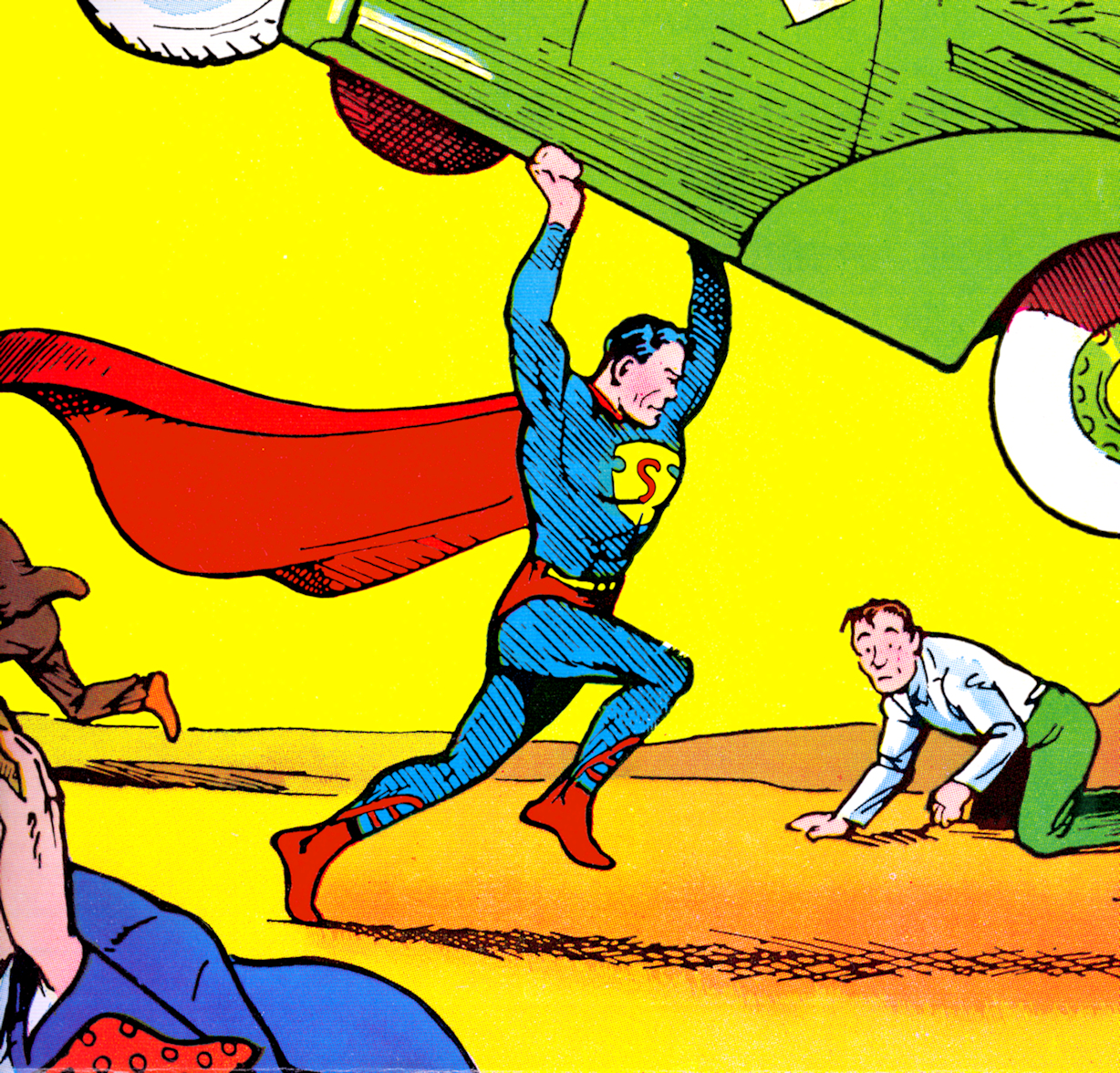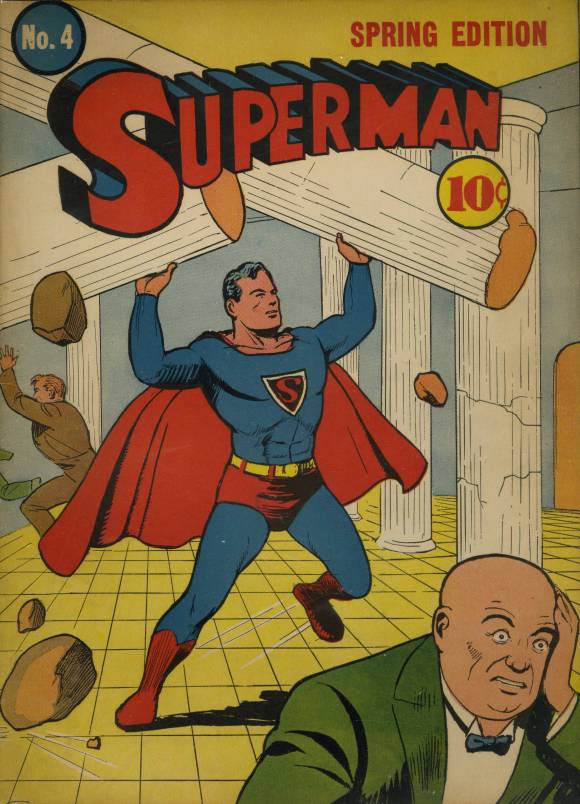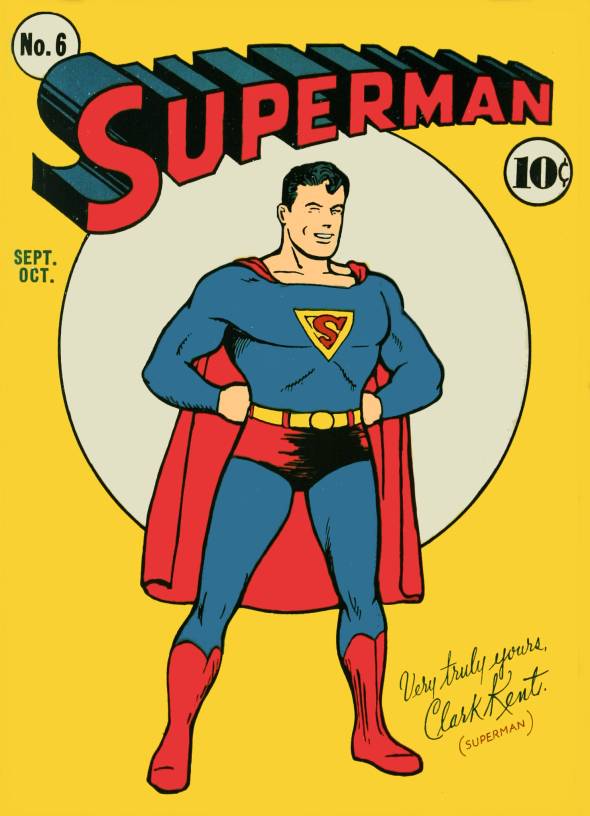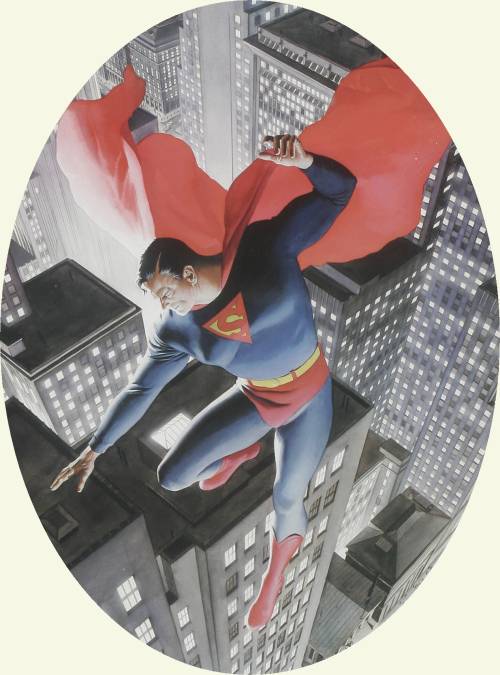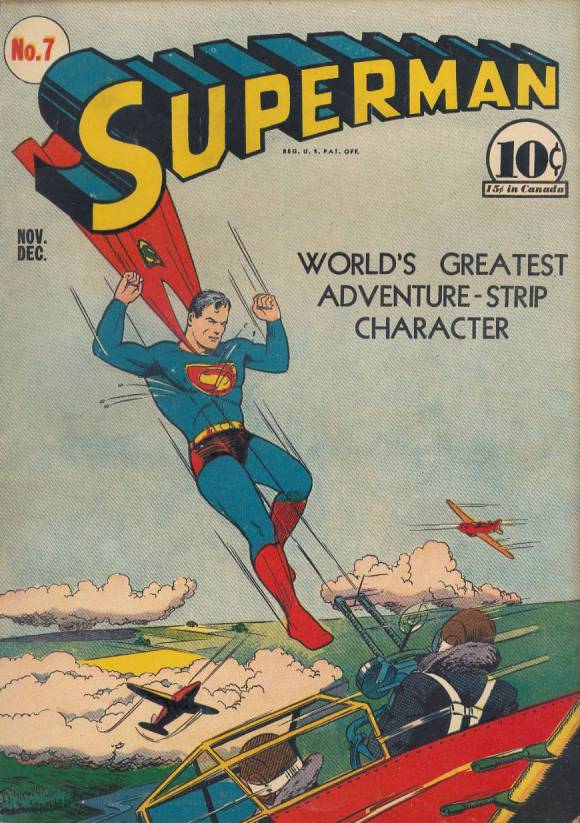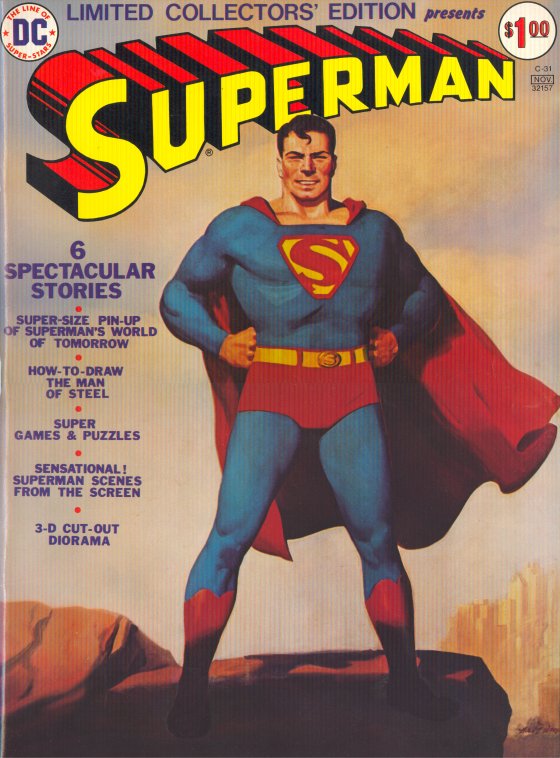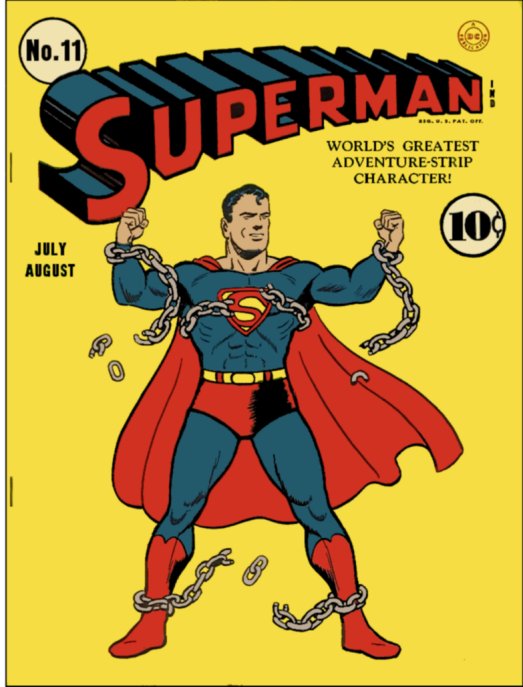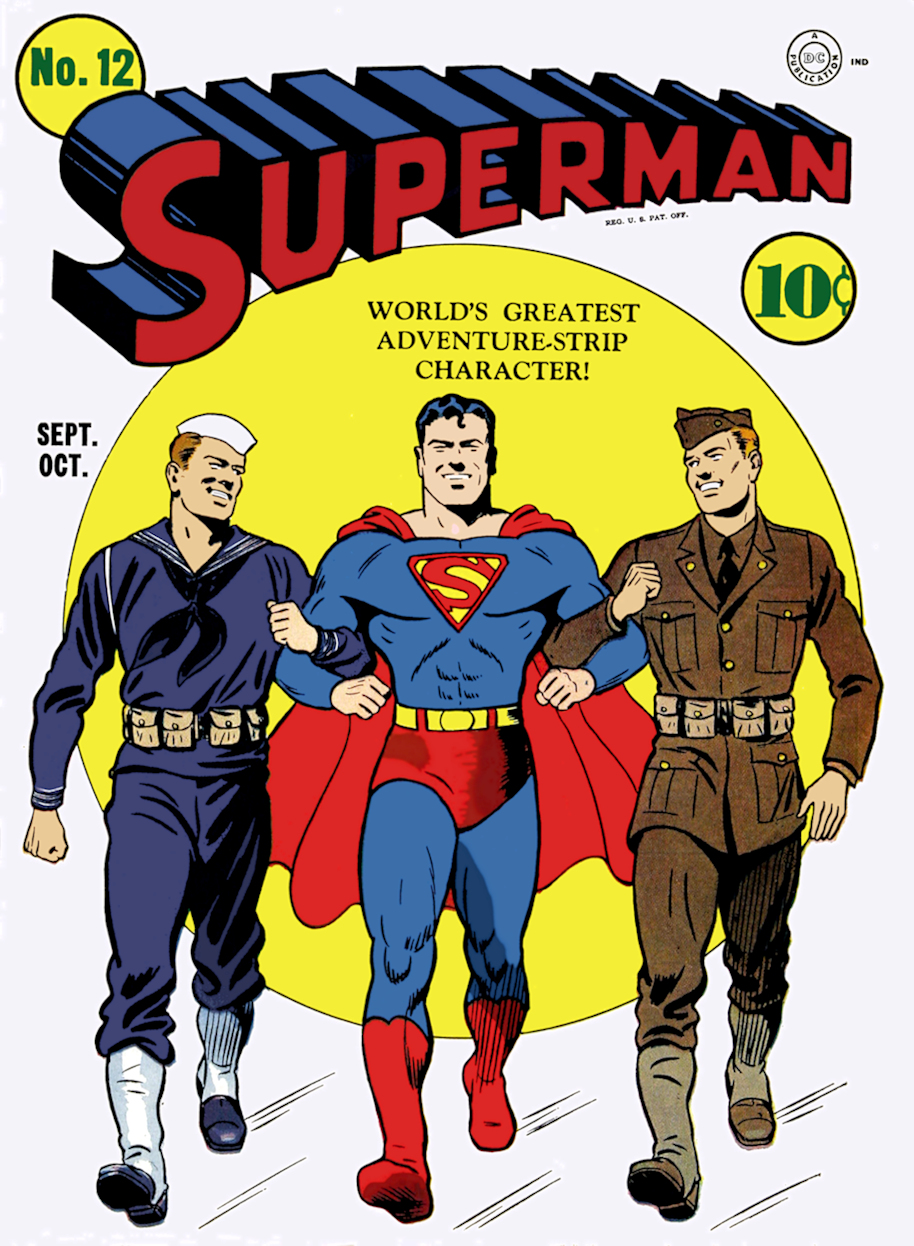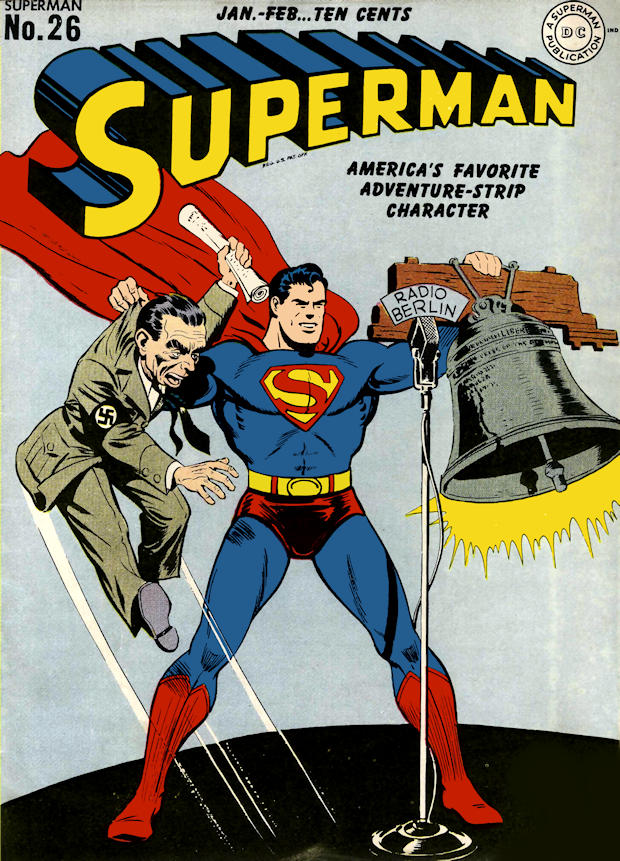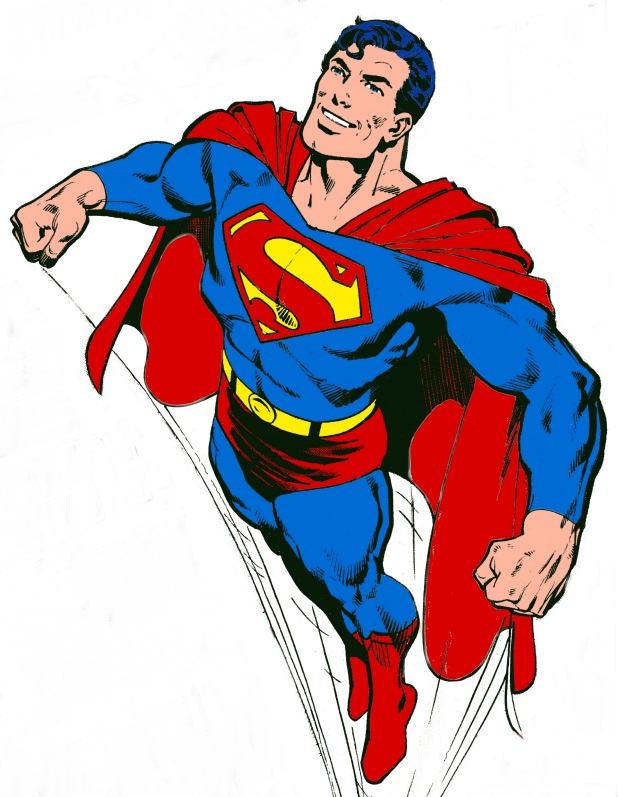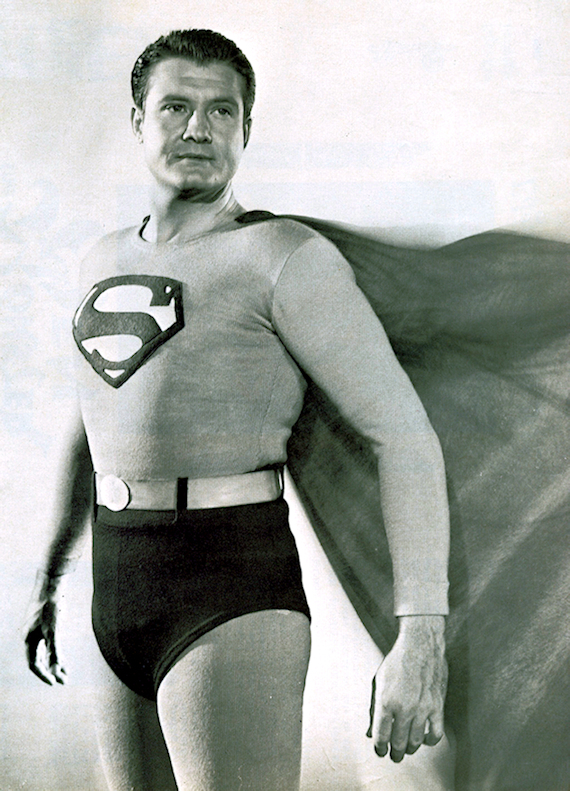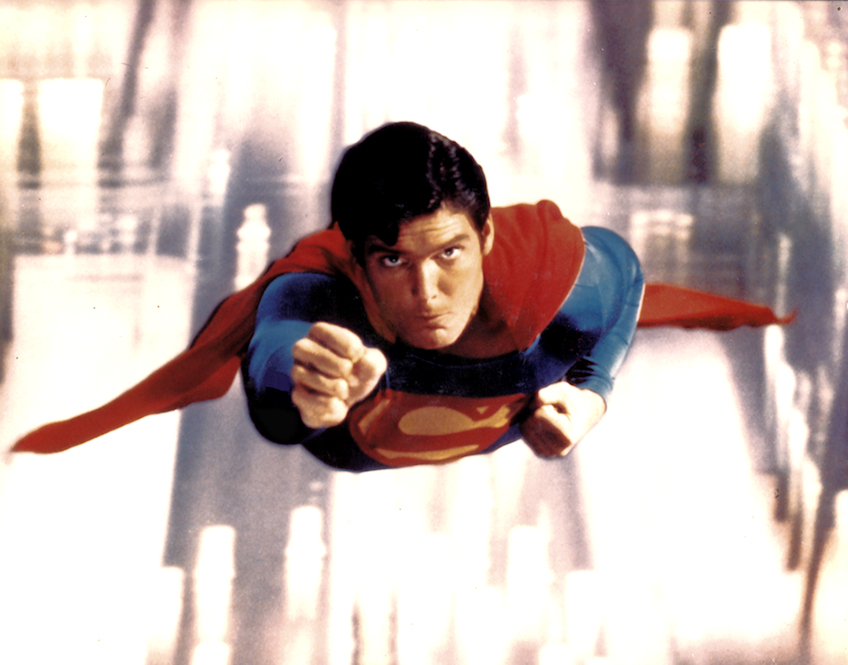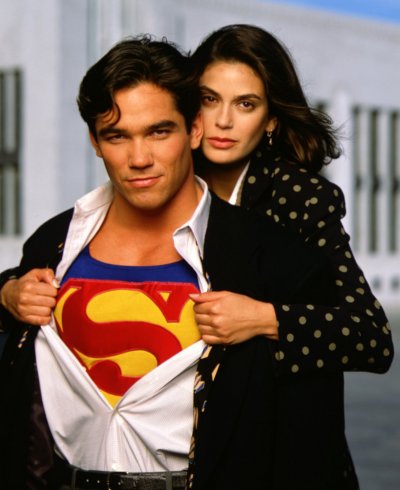Current Events


Action Comics
Superman's early years as Metropolis's protector are explored in
Action Comics, written by
Grant Morrison. Five years later, Superman's adventures continue with a new status quo in
Superman, written by
George Perez.
Origin

Destruction of Krypton
Although Superman's origin story has been retold and revamped many times, there has always been a basic origin story which most people are familiar with. Superman's story tells of his birth as Kal-El to renowned scientist
Jor-El and his wife
Lara on the alien planet
Krypton. When Jor-El discovers that the planet is going to explode, he puts Kal-El in a spaceship heading to the planet Earth, which crashes in a field in the state of
Kansas.
Jonathan and
Martha Kent find the wreckage and raise Kal as their own, naming him Clark and teaching him simple, honest morality. As his powers emerge, he moves to the city of
Metropolis to battle injustice in all it's many strange and varied forms.
Creation

Evolution of Superman
Superman was created by American writer
Jerry Siegel and Canadian-born American artist
Joe Shuster in 1933. Contrary to his current incarnation, he first appeared as a bald, telepathic villain bent on dominating the world. He was called "Super-Man" in the short science fiction fanzine "The Reign of the Super-Man" which was published by the duo in 1933. Siegel and Shuster decided to re-write the character as a hero and took out the hyphen, renaming him Superman and re-imagining him with no resemblance to his earlier incarnation. They drew inspiration from heroes across myth and history such as
Samson,
Hercules,
Moses and other heroic figures. They also changed his motivations from trying to conquer the world to trying to make it a better place, fighting against the injustices like
Hitler and
Stalin in addition to everyday crime. Shuster and Siegel intended to make the character as colorful and distinctive as they could, drawing inspiration from the outfits worn by space characters in pulp magazines as well as the traditional outfit worn by circus strong-men, which informed the look of almost every superhero thereafter. Being avid movie fans, Siegel and Shuster gave the character the civilian name of Clark Kent, combining the names of actors CLARK Gable and KENT Taylor and partly basing the character on Harold Lloyd. The pair decided to feature Superman in a comic-strip format and they eventually sold it to Detective Comics, later known as
DC comics and in June of 1938, Superman made his debut in
Action Comics #1 and since then he has become one of the most famous and iconic super-heroes of all time.
Character Evolution
Golden Age

Golden Age
In the
Golden Age of Superman, Jor-L, a scientist of the planet Krypton, discovers that his planet is about to explode. He attempts to warn his fellow scientists of this impending catastrophe, but is dismissed as a crack-pot and laughed out of the scientific community. As a last-resort, he and his wife Lara place their infant son in a ship and rocket him into space where he drifts for an unknown amount of time before crash-landing to Earth and is discovered by Johnathan and Mary Kent. At first they intend to place to him in an orphanage, but relent at the last moment and decide to raise him as their own, naming him “Clark” and treating him as their son. As he matures, great powers began to manifest and before his parents’ deaths, they dub him Superman and urge him to use his powers for the forces of justice. His parents pass on and he moves to Metropolis to begin his career at the Daily Star (later known as the
Daily Planet) so that he could hear about trouble as it’s happening. Superman’s time as a hero had him getting directly involved in World War II, carrying Stalin and Hitler to the UN to face a trial for their human rights violations. He also becomes the protector of Metropolis, but unlike his later incarnations he’s extremely aggressive and vicious, often murdering his powerless foes, and having little regard for the collateral damage he inflicts. This attitude lasted until the end of the 1940's when new editor
Whitney Ellsworth banned the character from killing, even having Superman vowing to never kill anyone ever again and if he did he would retire. Several of the series's supporting characters were introduced in this age, most notably
Lois Lane, a fellow reporter who would be Superman's love interest and eventually his wife.
Silver Age

Silver Age
During the
Silver Age, DC Comics decided to create two Supermen instead of just updating the Golden Age
Superman. To that end, they introduced Superboy, who was a younger version of Kal-El and travels to the future to help the
Legion of Superheroes fight evil across the year 3000. Additionally:
Supergirl is first introduced as Superman’s cousin during the late 1950s and serves the role of kid sidekick along with the menagerie of super-animals (including
Krypto,
Beppo,
Streaky and
Comet). Many of Superman’s most iconic villains are introduced in this era, and most of them take on a science fiction theme, including
Brainiac and
Bizarro. Superman also helps found the
Justice League of America, marking one of the first pan-label crossover teams in comic book history. During the 1960s, his origin is revealed: Superman was born on Krypton, to Jor-El (a slight change from the Golden Age Jor-L) by Lara Lor-Van. Rejected by the Science Council, Jor-El labors to build a vessel that can transport his family away from the impending catastrophe. The planet’s destruction begins before Jor-El predicted, however, and he can only send his son.
Kal-El’s ship lands in
Smallville and is discovered by Jonathan and Martha Kent (an earlier version identified them as Ethan and Sara Kent), who adopt the boy and raise him as their own, naming him Clark (which was Martha's maiden name). Clark discovers his powers while still a baby (See
Superbaby) and learns to control them as he matures. Clark convinces his mother to sew him a costume and fights evil as Superboy in Smallville while also becoming a member of the Legion Of Super-Heroes in the year 3000. He is assisted by his pet,
Krypto the Superdog, who also escaped Krypton in a prototype rocket launched by Jor-El, and thus had similar powers to the Boy of Steel. Childhood friends,
Lana Lang and
Pete Ross, round out his supporting cast and give him a connection to Earth beyond his parents. When Jonathan and Martha Kent both die of a disease for which even Superboy cannot cure, Clark moves to
Metropolis and attends Metropolis University, continuing his adventuring throughout his college career. He eventually changes his name to Superman upon graduating with a degree in journalism and gets a job at the Daily Planet soon afterward.
Bronze Age
Superman’s Bronze Age origin essentially lines up with his Silver Age story with the only difference being a removal of his Superboy adventures and his powers not emerging until puberty.
Modern Age

Modern Age
John Byrne rebooted Superman's origins following Crisis on Infinite Earths. Krypton was reinterpreted as a sterile society in which the populace no longer engages in skin to skin contact. Kal-El was conceived with machines and his fetus was housed in a birthing matrix until his arrival on Earth, making it so he was actually born on his new home planet. John and Martha survived into Clark's adulthood and helped keep him grounded. It was not unusual for Clark to visit them at the Kent Farm regularly. Lex Luthor was imagined as a business man who committed crimes through third parties and made it impossible to trace his evil doing back to him. But, most importantly, it was established that Clark Kent is the dominant persona, while Superman is more of them 'mask.' Prior to this, Clark was only a facade that Superman utilized in order to find out about potential disasters; the new Clark was assertive and capable, not just a milquetoast. The origin of Superman is retold in Superman: Birthright by Mark Waid. The story incorporates several classic iconic elements, but updates them. Once again, Clark Kent is used only as a tool for Superman's crusade. It's explained that he changes the pitch of his voice, slouches his shoulders and wears baggy clothes to hide his muscles, all while pretending to be clumsy and refraining from socializing with other staff members of the Daily Planet. Lex Luthor is said to have spent time in Smallville, similar to the show of the same name and the retroactive continuity first described in the pages of Superboy. John and Martha are depicted as being younger than usual, something that is also borrowed from the Smallville television show.and some of it is retconned. After Infinite Crisis, more is added to Superman's origin in Superman: Secret Origins.
Major Story Arcs
The Death and Return of Superman

Superman vs Doomsday
A mysterious creature crash-lands on Earth. It burrows slowly to the surface and begins a homicidal rampage across the rural area outside Metropolis killing everything in its path. The Justice League, minus Superman, arrive but the creature easily defeats them, severely wounding most members, with literally one arm tied behind its back. The Man of Steel arrives to engage the creature in battle, but finds they are equal in strength and unable to stop the beast, now dubbed ‘
Doomsday,’ from reaching downtown Metropolis. The two gladiators clash, finally killing one another with an incredibly strong pair of death blows delivered simultaneously.
Superman is laid to rest in a secure casket after a funeral ceremony attended by almost every hero in the DC Universe, but his legacy wouldn’t die. Four entities arise, all claiming the legacy of the Last Kryptonian: the youthful Superboy, the vicious
Eradicator, the mysterious
Cyborg and the determined
Steel. It quickly comes to light, however, that Superman isn’t truly dead and returns at a fraction of his power, but still determined to battle evil. After the Cyborg shows his true nature as a genocidal maniac, the Eradicator joins with Superman, thus returning his powers and allowing him to triumph.
Brainiac

Superman meets Brainiac
Superman discovers, and destroys, a drone sent by Brainiac to seek out the Man of Steel. He examines it in his
Fortress, he finds evidence that all his previous encounters with Brainiac were merely battles against probes controlled remotely by the real AI. Upon hearing the name, Supergirl confides in her cousin that she was on Krypton when the interstellar supercomputer attacked the city of
Kandor, shrinking and stealing it. Superman blasts into space to intercept the living computer before he reaches Earth, but encounters him in a distant galaxy abducting another city before setting off a super nova, knocking out the Kryptonian. Superman awakens inside Brainiac’s ship and begins to investigate, stumbling across an entire room filled with bottled cities, including Kandor, where he speaks to some of his living relatives.
Brainiac reveals his mission to collect cities from inhabited planets and then destroy the planets by triggering a supernova and Earth is, of course, his next target. The Justice League battle Brainiac’s forces and Supergirl stops the missile that would have exploded the Earth’s sun. Sadly for Superman, Brainiac has learned his identity and sends a missile to the Kent farm. Though no one is injured, Johnathan Kent, Clark’s father, suffers a fatal heart attack. Superman is left to deal with one of the only times he couldn’t save a life.
The New 52

Action Comics #1
At least five years prior to present events, Superman is hunted down by the police of Metropolis. After intimidating a criminal and coercing a confession through intimidation, he is confronted by the police with assistance from the military. It's revealed that Lex Luthor has been hired as an outside consultant for the army and plots to take down Superman. He refers to Superman as "it" and is generally disgusted by the alien. After escaping his pursuers, we find out that as Clark Kent he works for the Daily Star rather than the Daily planet, but is still good friends with Jimmy Olsen and at least acquaintances with Lois Lane. He lives in a small apartment in Hob's Bay that he rents from Mrs. Nyxly, who relays a story she heard about Superman confronting a wife beater, a reference to the original Action Comics #1. While he is at home, he discovers danger concerning Lois and Olsen and, as Superman, goes to stop a train they are riding, falling into Lex Luthor's trap. The train damages him and causes him to bleed from the ears. He loses consciousness and is captured. After being tortured with electricity by Luthor (who after finding the corpse of a dog, most likely Krypto, assumes Superman has taken on human form and actually resembles a canine-like creature), he escapes the facility, retrieving his cape - now revealed to be indestructible and presumably the blanket he was found in - which was being experimented on. On the way out, he finds the rocket that brought him to Earth which speaks to him in English. He says he will come back for it. Meanwhile, Lois confronts her father, Sam Lane, who is working with the military, about Superman's capture. She also meets John Corben, not yet transformed into Metallo, who reveals he has romantic feelings toward her.

Superman #1
In the present day, the Daily Planet has been purchased by a corporation. The original building has been torn down, replaced by a much larger structure. Superman is well known and respected. It's stated that he has been missing for some time. Clark Kent is upset over the changes to the Planet and debates he's had with Lois are shown through flashbacks. A creature of fire attacks Metropolis and Superman defeats it, but it's shown that its presence is part of a larger event that has yet to reveal itself. After dispatching the monster, he goes to apologize to Lois as Clark, but she is busy with a shirtless man named Jonathan Carroll in her apartment. As he leaves, he uses his super hearing to eaves drop on what they are saying and sadly goes home alone.
Powers & Abilities
Energy Absorption
As a Kryptonian, Kal-El possesses the ability to absorb the light and radiation of stars, specifically those in the yellow spectrum. His Kryptonian body is constantly absorbing and storing energy from Earth's yellow sun, which in turn grants him incredible powers, such as superhuman strength, enhanced senses, impenetrable skin, and even the ability to defy gravity. His body is also able to absorb the radiation of a blue sun, this grants him increased strength and various other powers.
Superhuman Strength
Superman has the ability to lift massive amounts of weight. Kal-El's strength is so vast due to the absorption of yellow solar radiation his Kryptonian physiology empowers his entire body, including his musculature. Superman is easily in the class-100 strength this is the ability to lift over 100 tons under normal conditions. Also Superman's strength is aided in lifting/supporting the most massive objects, especially when flying by the bio-electric force field his body produces which encompasses his entire body. Superman is so strong that during the DC vs Marvel crossover he was able to knockout the Hulk.
Superhuman Speed
Due to Superman's Kryptonian physiology has has an enhanced metabolism, muscular speed, and nervous system he has been granted a speed that is much greater compared to that of a human. He is able to see and avoid objects moving at incredible speeds and is also able to move faster than the human eye can perceive. When his body is charged with solar energy he is able to avoid laser fire at point blank range. Kal-El is also able to see other beings moving at superhuman speeds and can constantly move at a superhuman rate but this drains his solar reserves very fast if he is not under a yellow star at the time.
Superhuman Vision (Telescopic, Microscopic, X-Ray)
Kal-El is able to see over great distances and perceive even the smallest of objects. This vision also allows him to see through the atomic structure of an object, though he is unable to see through lead.
Heat Vision
Superman’s physiology can covert stored solar energy into beams of highly concentrated heat energy which can reach temperatures comparable to those produced by stars. The two beams of energy which are released from his eyes are bright red in color, but at lower temperatures can be made invisible, allowing him to work undetected.
Super Hearing
Kal-El has the super human ability to hear all sounds at any volume or pitch.
Superhuman Stamina
Superman’s Kryptonian physiology allows him exert himself to physical peak for an undetermined amount of time. When Kal-El is under a star with a yellow spectrum he is constantly replenishing his solar reserves. When Kal-El is under a G type dwarf star with a yellow spectrum his solar energies are constantly being replenished. Although he will not lose his abilities due to being under this star at one point he still will require rest.
Invulnerability
Due to his Kryptonian physiology Kal-El has a bio-electric force field that protects his body from harm. His muscular tissue is much denser than that of a normal human. He has been able to withstand a 1 mega-ton nuclear explosion, a force equal to one million nukes, planets colliding, and also a fight with Superboy Prime.

Flight
While Superman's body is charged with solar energy he is able to emit a gravitational field that enables him to defy gravity. Kal-El has extreme mobility while he is in flight allowing him to fight, change course and also carry great weights. While in Earths atmosphere Kal-El is able to move at high Mach Speed and while in space he can move at beyond light speeds. Kal-El tends to avoid moving at FTL speeds while in a planet’s atmosphere so that he does not harm the area around him. Kal-El has been seen flying from the Earth to the moon in mere seconds.
Freeze Breath
Kal-El has the ability to freeze his enemies using his breathe. He is able to control the temperature with which he expels this power.
Super Breath
Kal-El has the ability to suck in a large amount of air into his lungs and either hold it within him for a long period of time or create strong forces of wind with it.
Longevity
Yellow sun powered Kryptonians can live almost indefinitely.
Total Recall
Kal-El has the ability to instantly recall events that he pays specific attention to or that hold great emotional significance to him. When he has absorbed solar energy he has the ability to solve problems with superhuman speed.
Weaknesses, Limits, and Vulnerabilities
Magic
Superman is still a mortal and is, as such, still vulnerable to the workings of magic in all its forms. However, he is more resilient to it than others due to a gift from the Phantom Stranger which protects him from magical attacks.

Kryptonite
When Krypton exploded, its fragments crossed through a radiation belt that irradiated them, making the rocks extremely toxic to anyone with Kryptonian physiology, but mostly harmless to anyone else. The mineral causes Superman to lose his powers and experience extraordinary pain and eventually death. If suffering
Kryptonite poisoning, can recover if he gets away from the Kryptonite and exposes himself to yellow sun radiation, fueling his healing factor. Kryptonite has, however, been known to cause harm such as cancer to non-Kryptonians after prolonged exposure to its radiation.
Lead
Superman cannot see through lead
Red Sun Radiation
Superman is weakened when exposed to red solar energy. Superman will lose his Kryptonian abilities when exposed to red sun energy and must be recharged by yellow sun energy in order to regain his abilities.
Physical Statistics
Height: 6' 3"
Weight: 235 lbs.
Hair: Black
Eyes: Blue
Other Media
Print
The Adventures of Superman (1942)
The first Superman novel came out in 1942 and was written by George Francis Lowther, a writer for the syndicated radio program. In this tale, Superman’s powers manifested around puberty and thus side-stepped the adventures of the “Superbaby.” It follows the complete origin story from Jor-El on Krypton through Clark Kent going to work for the Daily Planet, and onward to adventures involving ghost ships, mysteries and Nazi saboteurs.
Superman: Last Son of Krypton (1978)
Written by Elliot S. Maggin, Last Son of Krypton tells the story of Superman coming to Earth as an infant, his Superboy adventures, and finally his journey to Metropolis. His primary antagonist is an original villain, an alien overlord bent on conquering Earth. The Man of Steel must team with
Lex Luthor to find the lost documents of Albert Einstein and stop the mutual threat.
Superman: Miracle Monday (1981)
Elliot S. Maggin’s second novel had Superman going up against the forces of Hell itself. Samael sends the vicious demon C. W. Saturn to Earth to ruin Superman morally with the help of Lex Luthor. The creature possesses
Lois Lane’s assistant and uses her as a conduit for its demonic power, even revealing Superman’s identity to the world as it causes destruction and death. It insists that Superman’s only recourse is to kill its host, thus breaking his most sacred vow, but Superman still refuses, stating that if he must battle Saturn for the rest of his life, he will. Saturn’s power is thus undone and he must grant Superman one wish, which of course the Man of Steel uses to undo all the damage done, including the revelation of his identity.
Radio and Other Audio
The Adventures of Superman (1940's), starring Bud Collyer and Joan Alexander with Agnes Moorhead portraying Kal-El's mother Lara in the first episode. In these radio programs, Superman grows to adulthood on his space voyage from Krypton to earth, and emerges with his powers. There is no mention of Smallville or the Kent family. The first people he rescues suggest both the name 'Clark Kent' and that he should seek a job as a reporter in a big city to him.
The Adventures of Superman (1966)
Vinyl LP featuring Bob Holiday as The Man of Steel
Film
You can find a full list of Superman's movies
here.
Television

Kirk Alyn
A 15 part serial in which the origin is explained as well as his fight with Lady Spider. Kirk Alyn and Noel Neill star.
Atom Man vs. Superman (1950) Another 15 part serial in which Superman battles Lex Luthor and Atom Man. Kirk Alyn, Noel Neill, and Lyle Talbot star.
Superman and the Mole Men (1951) starred George Reeves and Noel Neil.
Stamp Day for Superman(1954) was a short film promoting Stamp Day for the U.S. Treasury. Starring George Reeves and Noel Neil.

Noel Neill & George Reeves
Starring George Reeves as Superman/Clark Kent with Phyllis Coates as Lois Lane in season one before being replaced by Noel Neill for the remainder of the series. From 1952-1953 the show was shot in black and white, and every season after was shot in color. The series follows Superman's Adventures against mobsters, mad scientists and thugs, as well as dangers that do not pertain to humans such as asteroids and machines that went haywire. It also shows the transition he goes through as Clark Kent, mild-mannered reporter and Superman, the people's champion. Lex Luthor and Brainiac did not make an appearance in the series.
George Reeves makes a cameo appearance as Superman in the episode entitled "Lucy and Superman".
The Adventures of Superboy (1961)
A series pilot that was never aired, it starred Johnny Rockwell as Clark Kent.
It's a Bird, It's a Plane, It's Superman! (1975)
A televised version of the Broadway play, starring David Wilson and Leslie Ann Warren.

John & Gerard
Starring John Haymes Newton (1988-1989) and Gerard Christopher (1989-1992) as Superman. It was renamed The Adventures of Superboy in the third season. The series introduced Lana Lang as well as Lex Luthor. The series was supposed to end with Superboy's Death, with hopes of TV movies to follow the series but it wasn't as planned and the series would change it's ending to show that Superboy was in fact alive and well.

Lois & Clark
Starring Dean Cain as Clark Kent/Superman and Teri Hatcher as Lois Lane. The series followed the concept of Clark Kent in the spotlight, and focuses on the relationship between Lois and Clark. The series starts in 1966 with Jonathan and Martha Kent finding the baby Kal-El in a Kansas corn field and bringing him up their own son. Clark’s parents are much more prominent in this show than previous ones, as they’re shown visiting him often in Metropolis. Clark is around 27-30 when he comes to Metropolis and gets a job with the world-famous Daily Planet run by Perry White (Lane Smith). At the start of the series Lois views Clark as a pest when they are partnered, but Clark is smitten from the first and endures her jibes and taunts as well as the overtures of Lex Luthor, who appears in the first season and begins to court Ms. Lane, who is drawn to the charming businessman. Lex Luthor also wages his personal war against Superman, trapping the Man of Tomorrow with a Kryptonite trap, but Superman escapes and battles Luthor, who apparently falls to his death.
In season 2, Lois and Clark begin to date. Though they are constantly pulled in different directions and face various dangers, Lois soon finds out Clark's secret identity and in the season finale, Clark proposes to Lois, but she must know who is asking: Clark Kent or Superman? Lois is unsure because of how long Clark kept his double-life secret from her, so she is unsure that the marriage can work. This was also a device to delay the in-show wedding as it was meant to coincide with the marriage in the comics, which was delayed. In the final season, Clark is confronted with a colony of Kryptonians, who want to force Kal-El to journey to their colony and help them survive. The series ends on a cliffhanger as Lois and Clark discover a child with a note attached on their doorstep. The note explains that the child is theirs.

Tom Welling as Clark Kent
Smallville stars Tom Welling as Clark Kent, Michael Rosenbaum as Lex Luthor, Kristen Kreuk as Lana Lang, Allison Mack as a new character
Chloe Sullivan, Sam Jones III as Pete Ross, Anette O'Toole as Martha Kent and John Schneider as Jonathan Kent. In later seasons Erica Durance stars as Lois Lane, Laura Vandervoort as
Kara Zor-El, Justin Hartley as
Oliver Queen/Green Arrow, and Callum Blue as
Zod. This series centralizes on Clark Kent becoming Superman.
Animation
Superman (1941-1943)

Max Fleischer's Superman
This animated series marks the Man of Steel's first film appearance. Max and Dave Fleischer (of Fleischer Studios) created this series primarily under the direction of Paramount Studios. It should be noted that Dave Fleischer, the animation lead on the project, actually collaborated with Joe Shuster on the look of Superman, thus seamlessly blending in Superman's original comic book look with the Fleischer's unique and beautiful brand of animation. It is difficult to underestimate just how important this serial has been on the rest of Superman mythology, print and visual culture. For example, this serial gave birth to many Superman stock phrases such as "faster than a speeding bullet, more powerful than a locomotive, able to leap tall buildings in a single bound...", "this looks like a job for Superman!" and "look, up in the sky! Its a bird! Its a plane! Its Superman!" On a similar note, it has been mentioned that in the 1938 comics Superman was only able to leap tall buildings. It is in this series, in fact, where Superman learns to fly. For example, in the earlier 1941 cartoons Superman is seen getting a running start before taking off, a reference to its extension of his jumping ability, whereas by 1943 he had gained full control. The decision to transition from leaping to flying was made by the Fleischer brothers, who decided that leaping did not look right on film, whereas flying was much more visually appealing, being perfectly suited to the freedom that animation provided (Superman's flight effect looked so good in animation that it continued on into the live action 1948/1950 Kirk Alyn Superman serials for Columbia, where whenever Superman flies he is animated, and whenever he lands he conveniently ducks behind cover and emerges as the live action Alyn). Shortly after the introduction of flight in the animated serial the print Superman also gained the ability.
Super Friends (1973)
The All-New Super Friends Hour (1977)
Challenge Of The Super Friends (1978)
The World's Greatest Super Friends (1979)
Super Friends (1980)
Super Friends "lost episodes" (1983)
Super Friends: The Legendary Super Powers Show (1984)
The Super Powers Team: Galactic Guardians (1985)
From 1973-1986, Superman was a member of the Super Friends, a kid-friendly version of the JLA. He was voiced in all the incarnations of the Super Friends by Danny Dark.
Superman (1988)
Ruby-Spears produced this cartoon, which was based off of John Byrne's overhaul in the comic books. This version of the cartoon was created in part to celebrate Superman's 50th anniversary and also to serve as a companion to the live-action Superboy show. Beau Weaver provided the voice for Superman.
Superman: The Animated Series (1996-2000)

Superman: The Animated Series
After the success of Batman: The Animated Series, Bruce Timm expanded the newly forming DCAU with Superman: The Animated Series (1996-2000). It also has a slightly different twist to things with Brainiac being shown as a Kryptonian "machine" as opposed to being from
Colu and that it was him that caused the destruction of Krypton, we also see
Kyle Rayner become the first Green Lantern (with some help from Superman of course) instead of
Hal Jordan. The series has appearances from villains such as
Metallo,
Darkseid, Brainiac, Bizarro,
Kalibak,
Livewire,
Bruno Mannheim,
Toyman and even some of
Batman's rogues gallery. There were also appearances from the Legion of Super-Heroes, Steel,
Aquaman, the Flash (presumed
Barry Allen) and Supergirl (though not portrayed as a biological cousin, often wears Linda Danver's white uniform rather than the traditional red and blue). Also making a cameo was Batman, who from this respawned the series, the New Batman Adventures, with Robin making a cameo later on in the series. Tim Daly and Dana Delany voiced Clark Kent/Superman and Lois Lane respectively, Clancy Brown voiced Lex Luthor.
In the two part episode "The Call", Superman is older and recruits the new Batman, but it turns out the Man of Steel is brainwashed and is attempting to destroy the Justice League. It falls to the new Batman to take him down using Bruce Wayne’s Kryptonite sample.
Features Superman as a founding member of the League voiced by George Newbern.
Makes a cameo in the episode "Toys in the Hood" voiced by Justice League actor George Newbern. The episode is a continuation from the Superman: The Animated Series episode "Obsession"

Krypto: The Superdog
Voiced by Michael Dangerfield in the pilot episode.
Featured in the Season 5 opener ("The Batman/Superman Story") which is two parts as well as the season/series finale which is also a two parter ("Lost Heroes")
In the newest Batman cartoon series which focuses on Silver Age characters teaming up with Batman, Superman has a cameo in the episode "Sidekicks Assemble!" along with Martian Manhunter and Wonder Woman (though their backs are turned and they have no dialogue). Superman cameos a second time in his Clark Kent persona in the episode "Knights of Tomorrow!" as a guest during the wedding of Bruce Wayne and
Selina Kyle.
In season three, Batman and Superman finally team up in the episode "Battle of the Superheroes," after Lex Luthor exposes Superman to
Red Kryptonite. This causes Superman to become evil and leads to Batman donning his "Dark Knight Returns" armor to take him down. Later in the episode Batman and Superman change places in order to expose Luthor's evil plan.
In this series, Superman is visibly disturbed by the introduction of Superboy and goes to great lengths to avoid his clone, placing responsibility for him on Batman and
Red Tornado. When Batman tries to tell him that Superboy needs a father, Superman angrily replies that he's not Superboy's father, but Batman believes that in time, Superman will come to accept Superboy.
Video Games
Superman has appeared in numerous games either as the main character with the story focusing on him or as part of a larger party where he is a main character
Superman Returns is an open-world tie-in to the film. Which features story missions based on saving the city of Metropolis, and 80 sq. miles of free roaming gameplay. It also has the unusual mechanic of not having Superman dealing with a lifebar, but with Metropolis dealing with one instead. Superman’s battles damage the city more and more, so caution must be taken to avoid collateral damage.
Justice League Heroes is an Action-RPG that allows you to play as members of the Justice League of America as they work together to take down the various villains in the game.
The game based on the famous team, Superman is a main character with his Earth-Two version as an unlockable costume.

MK vs DCU
Superman was one of the first DC characters announced for the game along with Batman. The game starts with Superman stopping Darkseid's invasion by blasting Darkseid with his heat vision as he enters a
boom tube. Superman’s immense power is dealt with through the introduction of Kombat Rage, which makes the strength of the Kombatants fluctuate wildly.
MK vs DCU: "As the planet Krypton braced for destruction, the infant Kal-El was placed in a rocket ship by his parents and sent into space. Arriving on Earth as the Last Son of Krypton, he was found and raised by Jonathan and Martha Kent on their Kansas farm. Clark Kent manifests the amazing powers of super-strength, flight, and invulnerability under Earth's yellow sun. Instilled with the values of right and wrong, he has taken on the identity of Superman to defend his adopted planet.
Superman (voiced by Adam Baldwin) is one of the player characters mentor's if following the meta-human path. He will appear throughout the game to guide the player character and provide opportunities to fight alongside each other.
When you reach a high level Superman will ask you to come to the
Daily Planet and assist him against
Lex Luthor, infiltrating the
Hall of Doom as the mission progresses.
ADVERTISEMENT

The legendary "Man of Steel" soars on Saturday morning television in the animated action/adventure series -- "The New Batman/Superman Adventures", which airs on Cartoon Network Monday - Friday in the Toonami block at 6:30pm (Pacific).
The timeless hero shines in his struggle for "Truth, Justice and the American Way." Set in present-day Metropolis against the backdrop of a bright, urban landscape, the ageless superhero combats sinister villains and rescues innocent victims in exciting new stories based on universal themes encompassing the time-honored traditions of the classic Superman legend.
Rocketed to earth by his parents Jor-El and Lara when a cataclysmic explosion obliterates their planet, Krypton, baby Kal-El is raised as Clark Kent by Jonathan and Martha Kent in Smallville, U.S.A. As a teenager, Clark discovers and hones his "super" powers, forges a close friendship with his female confidant
Lana Lang (who gradually becomes aware of his true identity), obtains a job at the Daily Planet and grows into a mild-mannered, yet hard-hitting crime reporter.
Clark's "mortal" life revolves around his work and friendships at the Daily Planet, including such renowned colleagues as Lois Lane, the savvy, quick-witted, imaginative and courageous ace reporter. Lane is quite skeptical of Superman's powers and is determined to uncover the mysterious legend. Rounding out Clark's Daily Planet "family" are: Perry White, the Daily Planet's managing editor, Jimmy Olsen, a budding young photographer and one of Clark's (as well as Superman's), most loyal pals, and Angela Chen, a stunningly beautiful gossip columnist for the newspaper as well as the "on-camera" hostess for "Metropolis Today."
True to the legend, if exposed to Kryptonite, Superman instantly weakens and prolonged exposure to it could, quite possibly, cause his death. Superman also has no power over magic -- he is susceptible to mystic spells like mortals. Kryptonite and magic aside, Superman is "equipped" to handle anything else. In addition to his extraordinary superpowers, this animated series outfits the "man of steel" with special "exoskeleton supersuits" which help him function in hazardous situations -- a space suit, allowing him to breathe in outer space and fly faster than the speed of light and an underwater suit for prolonged periods of time on the ocean floor.
Superman faces some of his most villainous foes ever in this series, including: Lex Luthor, Metropolis' megalomaniacial "ruler," and Superman's evil clone, Bizarro. Other antagonists are Jax-Ur and Mala who escaped from Krypton's Phantom Zone. A dimension for holding Krypton's worst criminals in a state between life and death. These adversaries have but one goal -- to eliminate Superman from the planet.
"Superman" is produced and animated by Warner Bros. Television Animation, under the creative supervision of producers Alan Burnett, Paul Dini and Bruce Timm.
THE STORY OF THE (AKA, "Superman's Symbol 101") | |
| | | |
| | Superman's Symbol. Pop Art. An Icon. The Original. An unique piece of Americana. Superman's "S" emblem is all of these things and more. As it is, Action Comics #1 is the "Big Bang" of Super-Heroes. There is no "super" in "hero" before "Super"man, after all. And if the Super-Hero is the modern "mythology" in our culture, then Superman began a tradition that is steeped in historic iconography. As Dan Brown's Robert Langdon would likely point out, symbols have power, and when Superman, the first and most successful Super-Hero in history, sported a Symbol on his chest, pretty much every superhero after that did, too (Batman, the Flash, Green Lantern, etc.). And not just the ones from DC, either - Atlas/Marvel did the same thing (at the beginning and even decades later, when they "reinvented" the Super-Hero) with Captain America, The Whizzer, Destroyer, Blue Diamond, Union Jack, Miss America, and then the Fantastic Four, Spider-Man, Daredevil and the lot of them. When people think "Super Hero", they think of someone with a cape, tights and some kind of icon on their chest. Superman's logo is instantly recognizable and you can see it utilized in advertisements for pretty much anything you can think of when someone wants to emphasize what they're doing is at the apex of its ilk, to the extreme, of the highest degree, the greatest ever. When it comes to attracting attention, Superman's symbol carries the day .
It didn't start out that way, though. Initially, it was not even considered a significant part of his costume by his publisher. In hindsight, though, it turned out to be the most important, overall, toward the end of protecting and sustaining the ability to publish the character in perpetuity.
Superman has been an icon for over 70 years and his symbol was the first of its kind. Prior to Superman, there was no such thing as a "Super-Hero", nor was there such a thing as a "Super-Hero Costume", nor was there a trademarked symbol that any fictional character had worn prior to Superman. As The Original Super-Hero, he and his symbol were the foundation upon which the comics industry has been built. There would have been no comics "boom" in the late 1930's, no Batman, no Sub-Mariner, no Human Torch, no Captain America, no Captain Marvel (Shazam! or otherwise) were there no Superman. There would be no DC Comics as we know it today. Marvel Comics would never have become a publisher of super-heroes and its Silver Age stable of characters (Spider-Man, the Fantastic Four, Iron Man, Daredevil, The Hulk, The X-Men) would be absolutely non-existent.
In 1945, National Periodical Publications (later simply known as "DC Comics") trademarked Superman's symbol, allowing the ability to print his stories in perpetuity, rather than allowing the printed material to become public domain after 75 years, as was the norm at that time. The ability to license and merchandise the character created another source of income for the comics industry.
Superman's symbol has become recognizable all over the world. However, at one time, it was not even very consistently drawn - and that is the crux of this article. Prior to having trademarked the symbol, it went through a great deal of metamorphosis (metamorphoses?). Here is the story as we know it.
NOTE: This page is currently under construction and will be updated as more information becomes available.
Metropolisplus.com has used primarily covers for the purposes of this article, as that is the part of the comic which attracted the most attention and were provided with the most detail and were printed with the best available reproduction of the day. We highly recommend the cover galleries for Action and Superman at The Grand Comics Database, which we have found to be extremely valuable for general research. While the images have been too small for our uses here, they were perfect for getting a fast look at 50 covers of one title at a time and being able to pinpoint the best covers to use.
In reviewing the symbol itself, first one must point to the origins of Superman. Jerry Siegel and Joe Shuster had created Superman years before he ever saw print. Only a few early drawings of Superman prior to publication survive to this day. Here is one of them, as published in Comic Book Marketplace #36: 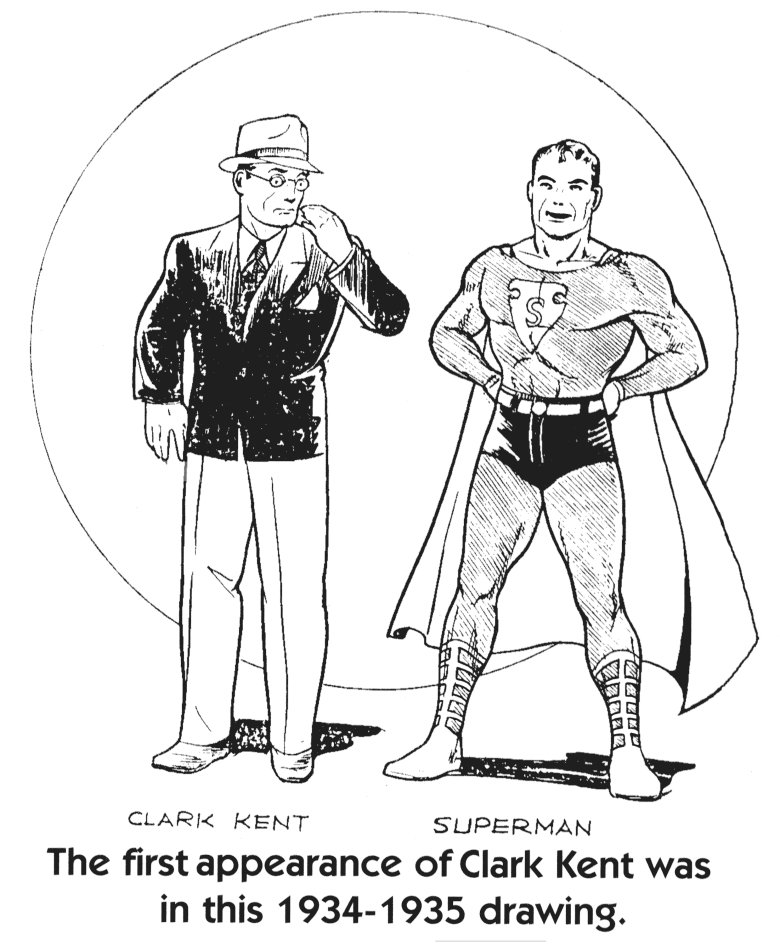
| |
| | As you can see, this symbol was quite different than it would become upon publication, with the exception of the cover of Action #1. Close inspection of superman's costume on the cover reveals that this was the same costume, boots/straps and symbol (this image was taken from Famous First Edition C-26, and we enhanced the coloring to follow the actual lines drawn for the symbol and the boots to clarify the image). A representation of the first symbol (click here) in its earliest form provided for comparison. This shield represented something akin to the shape of a police officer's badge (which would later become the shape of the hand-held shield of a later hero known as "The Guardian", who was a police officer in his secret identity - but that's another story...). Jerry Siegel and Joe Shuster had intended Superman as a comic strip character, but had been turned down by numerous syndicates. When they prepared Superman for his first comic book appearance, Joe cannibalized the strips and reoriented them into page form with slight adjustments for the difference in medium. Superman saw newspaper publication a year after his first comic book appearance and his appearance was similar, but you can see from the examples below that there was a considerable difference in the quality of reproduction. Superman's symbol takes on a triangular appearance in the pages of Action Comics, newspaper comic strips and the first few issues of Superman Comics. Superman only saw six other covers of Action Comics for the next 20 issues, one of which was a bit of a misrepresentation of his costume. The next time we see him on the cover of Action #7, his symbol appears more like that on the inside pages. This was further in evidence as late as 1940.
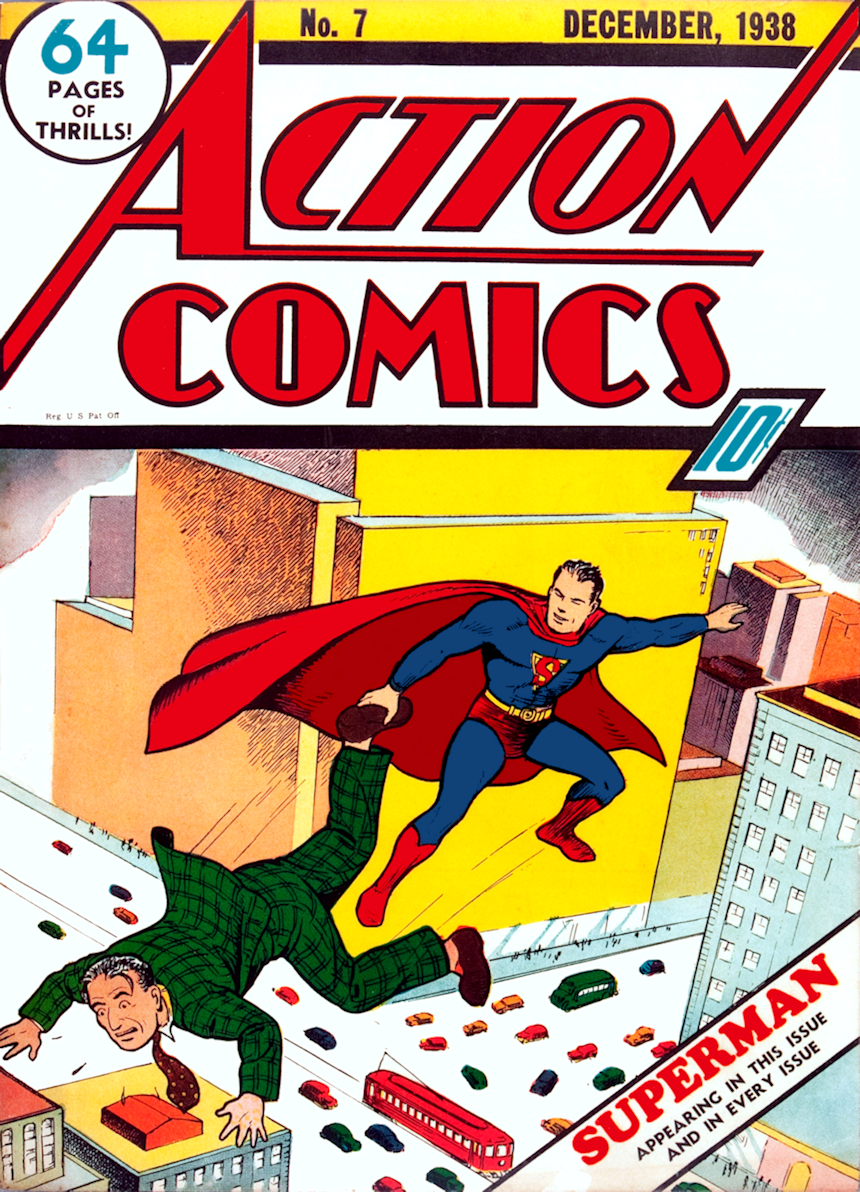
Click for a detail of Action #7. Here are the covers of Superman #1 and #4, which is the last appearance of the symbol in this form on a Superman cover. Once Shuster had a studio with other artists, the symbol became a bit less sketchy (although, only slightly less so) and had a larger presence in Superman's costume. Take a look at Superman #6: Alex Ross is a tremendous fan of this particular symbol and has used it in his representation of Superman #1, as well as using the above cover as the model for the statue he designed for The Ultimate Superman Collection: Below is the version that was used around 1940 when the Fleischer Studios began their cartoon shorts of Superman, as seen here with black in place of the typical yellow coloring in the negative space and surrounded by yellow, rather than red:
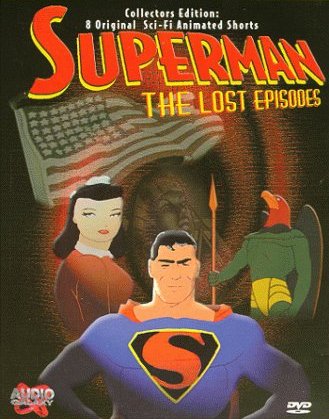 Here is a representation of the Fleischer/Black Symbol. While the black background and yellow diamond could have simply been an artistic preference, it appears to be an application of the Superman #4 cover symbol (see above), which appeared around the same time as the first Fleischer films. [Note: Comic book cover dates are much later than their actual appearance on the newsstands, as many newsstands pulled books based on their cover dates.] This approximate symbol also appeared as that used on the cover of a reprint reissue volume of Superman's comic strip adventures. There were several versions of the symbol as it continued to be published. This cover by Paul Cassidy, published August 1940, was the first cover depiction of the next most popular version of the symbol (as Joe Shuster drew less and less cover figures and his "ghosts", like Fred Wray, John Sikela and Wayne Boring began to work more and further into their own style). This symbol had a bit larger "S" than is shown in most stories, but it is far more difficult to get a clear shot of the symbol on interiors, so this cover from Action #26 serves as the first cover appearance of this symbol. Superman #7 follows suit, but mixes up the colors! 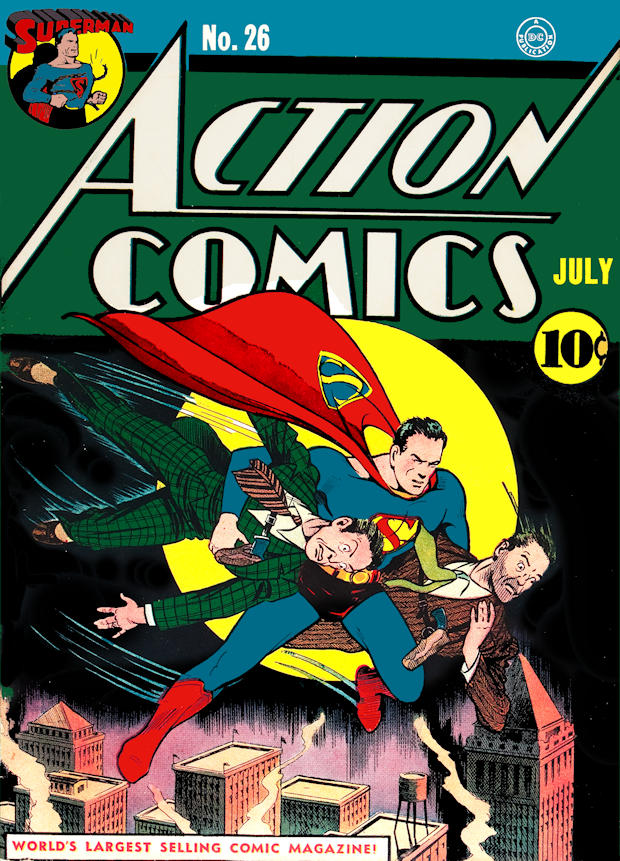 This was much closer to the current version, however, in late 1940, it underwent another odd change that went a bit further away from this version. The National Comics offices had a painting of Superman by H.J. Wray. I have seen photos taken in these offices that provided a sort of "before and after" version of Superman's symbol. Initially, the symbol appeared in the inverted triangle form, however, later, the very same painting had a much more elaborate version of the emblem. With this painting in the offices, there was an on-hand reference for those artists visiting the publisher. That painting as it appeared on Limited Collectors' Edition C-31: Here is a representation of this version of the symbol in color.
With Superman #9 and #11, published in 1941, a difference from the initial triangle shield began to take form. The symbol appeared differently again and this is how the Golden Age symbol was typically represented when artistic reference was used for the Golden Age/"Earth-2" Superman being depicted:
A representation of the Golden Age emblem in color.
That version of the symbol appeared on covers through December, 1943.
Some Fred Wray covers also had a different serif, more closely resembling the painting by H.J. Wray, such as Superman #12.
Click for detail of Superman #12.
There was one further evolution, which may have been due to National realizing that this property had "legs" and was going to be around for awhile. In order to be able to keep a property in publication for longer than 75 years, one would have had to trademark part of that character's appearance. Disney did it with Mickey Mouse and Superman was much easier to pull off, due to the emblem on his chest. In 1944 - the very next issue after Superman 25 - the trademarked version of the symbol appeared.
Probably the most popular Superman artist of all time still had to be Curt Swan, whose work is depicted here. Click here for the symbol as the general public became accustomed to seeing it.
And we can't forget what an impact "Crisis on Infinite Earths" had on the DC Universe back in 1985. The last page of the first series of John Byrne's Superman depicted the symbol thusly:
The symbol as it was presented from the John Byrne era on.
For comparison's sake, we've provided a collage of all these symbols. A Contrast from one period to another.
As mentioned previously, Superman has been Alex Ross's favorite character and Kingdom Come, like any story about heroes in the DC Universe, was a Superman story. When Superman reappeared, his symbol took another turn in it's constant morphing. Alex was quoted as indicating that he had always liked the way the Fleischers used black in the negative areas, so he created a deceptively simple design utilizing that idea.
The symbol as it was presented by Alex Ross in "Kingdom Come".
Think that the TV and Movie representations were perfect? Think again! Each, individually, has been the industry's best tries to date, with the exception of "Superman Returns". George Reeves had a laudable try in "The Adventures of Superman" on television (the same suit was originally used in the Kirk Alyn serial).
Here is a representation of the symbol taken directly from a head-on photo of this original costume.
Christopher Reeve had another very close attempt in the "Superman" movies.
Even closer was the symbol from the late, great TV series, "Lois & Clark: The New Adventures of Superman", in which Dean Cain played the titular male character.
Here's a representation of that selfsame emblem, using the same colors as the outfit.
As we neared the premier of "Superman Returns", we were consistently reminded of the importance of Superman's symbol. The trailers and teasers utilized it repeatedly and it stirred the emotions of moviegoers and web-surfers everywhere. While previous live- action versions of Superman in film or television had not quite perfected the art of the "S" shield, this one tried a new tactic by going with a plastic relief (3-D) version that was not only on his chest, but they included one on his belt... okay, maybe not a very good choice.
The version used in the 2006 movie "Superman Returns".
I hope you enjoyed this complete waste of your time - I sure did!
|







 18 Novembro 2010
18 Novembro 2010 Daniel
Daniel

































